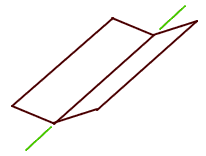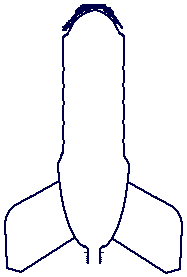Water Rockets - 1 litre Power Rocket
The PET
 |
Initial
state of the bottle
blanks that make the bottles that we use for water
rockets are also used for some soft drink cordials,
squash bottles and so on. These bottles are not meant
to hold any pressure and to stop them collapsing when
the purchaser picks up the bottle, they have
corrugations in the cylindrical part of the bottle.
They seem to be made from the blanks that 2 litre
bottles are made from and the plastic is noticably
 |
With the
bottom blown out and the sides shrunk
thick. With them being fairly small in diameter, they
are ideal for higher pressure launches. I wanted a
rocket that I could launch at 140 psi for altitude
and for downrange distance - this looked ideal.
The first thing that I did once I had emptied
and cleaned the bottle was to blow out the concave
bottom. I did this by pressurising the bottle, using the
cap with the one-way valve in the bottom that is
described previously and carefully heated up the bottle
over the gas stove. The bottom blew out reasonably well
so I thought that it might be a good idea to see if I
could straighten out some of the corrugations as well.
The intention was to make the bottoms of each
groove the same height as the material on either side but
the whole thing went smaller instead. If anything, the
bottle ended up stronger as the plastic was thicker and,
the diameter was smaller for a larger proportion of its
length.
| I then cut some fins from the
side of a bottle like so . . . |
 |
|
 |
|
 |
|
 |
| Cut a
straight-sided cylinder, |
|
cut up one side, |
|
fold it in half
and |
|
mark out and cut
the fins. |
I stuck the three  fins on the rocket with tape and then
weighed it full and empty. This gave me the weight of the
rocket empty (effectively the minimum weight of the
rocket on the simulator) and the capacity of the rocket
body. fins on the rocket with tape and then
weighed it full and empty. This gave me the weight of the
rocket empty (effectively the minimum weight of the
rocket on the simulator) and the capacity of the rocket
body. Any weights are taped onto the nose of the rocket and
tape is used to make the rocket roughly aerodynamic.
Here are the vital statistics . . .
| Mass of empty rocket |
100 |
g |
|
| Capacity of Pressure Vessel |
900 |
cm3 |
|
| Rocket Diameter |
6.5 |
cm |
|
| Rocket Coeff of Drag |
0.42 |
|
* |
| Nozzle Diameter |
21.75 |
mm |
|
| Constant K for nozzle |
0.22 |
|
* |
| Duration of air impulse |
20 |
ms |
* |
| *
guess based upon figures |
I pressure tested it to 140psi and there was no
sign of any damage so this seemed to be a reasonable
pressure to launch at. Note that to pressure test a
bottle, you should fill it completely with water so that
there is little or no air inside to store the energy that
would do the damage should the bottle burst.
The following is the table for maximum height and
downrange distance at various pressures using the rocket
that I made.
| H e i g h t |
| Pressure (psi) |
50 |
75 |
100 |
125 |
150 |
| Actual or Ideal |
A |
I |
A |
I |
A |
I |
A |
I |
A |
I |
| Water (g) |
285 |
210 |
285 |
240 |
285 |
240 |
285 |
240 |
270 |
255 |
| Rocket (g) |
100 |
40 |
100 |
55 |
100 |
65 |
100 |
70 |
100 |
80 |
| Height (feet) |
105 |
135 |
155 |
180 |
200 |
220 |
245 |
255 |
280 |
285 |
| D o w n r a n g
e D i s t a n c e |
| Pressure (psi) |
50 |
75 |
100 |
125 |
150 |
| Actual or Ideal |
A |
I |
A |
I |
A |
I |
A |
I |
A/I |
| Water (g) |
290 |
245 |
295 |
265 |
280 |
270 |
270 |
270 |
285 |
| Rocket (g) |
100 |
55 |
100 |
70 |
100 |
85 |
100 |
95 |
110 |
| Angle (degrees) |
47 |
41 |
43 |
40 |
41 |
40 |
39 |
39 |
39 |
| Distance (m) |
55 |
65 |
80 |
85 |
100 |
100 |
115 |
115 |
130 |
I have fired this rocket and tested the
downrange capabilities of it and it works fine. The
calculations are spot on. I have also fored it stright up
and the amount of time that it is in the air gives it the
wow factor as far as newcomers are concerned. On the
pictures page, you can see the results of this little
beast hitting the football pitch which, while wet, was
sufficiently solid to walk on.
To
the pictures . . .
 Back to the Real Rockets Index Back to the Real Rockets Index
 Back to the Water Rocket Index Back to the Water Rocket Index
|






 fins on the rocket with tape and then
weighed it full and empty. This gave me the weight of the
rocket empty (effectively the minimum weight of the
rocket on the simulator) and the capacity of the rocket
body.
fins on the rocket with tape and then
weighed it full and empty. This gave me the weight of the
rocket empty (effectively the minimum weight of the
rocket on the simulator) and the capacity of the rocket
body.